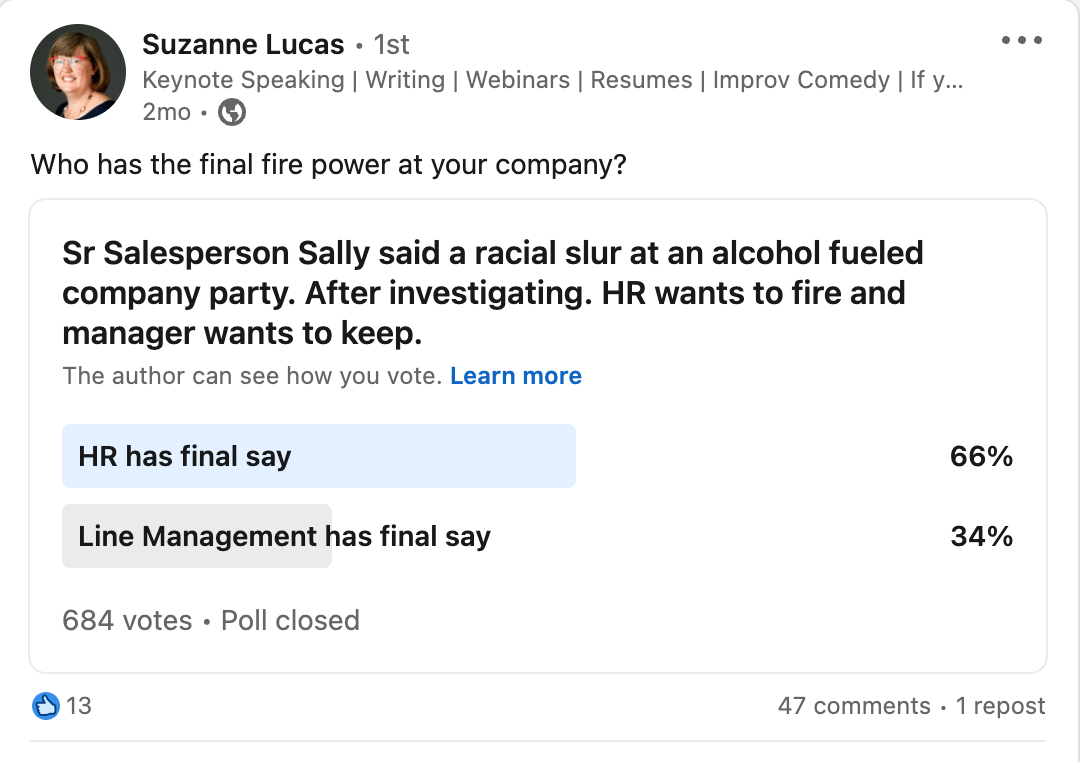Who has the power to fire? It depends – to a degree
“I got fired by HR. My manager says he doesn’t even know why I got fired.” Statements like this are annoying. It’s as if there are evil HR ladies (ahem) lurking around corners, just waiting to terminate people.

That’s not how it happens.
Who has the final decision-making authority for termination decisions? When is HR the decision maker? When is it the manager?
There needs to be more clarity around this issue
I posted three separate polls on this issue, all asking the same question: Who has the final firepower?
But for each, I gave a different situation:
1. Entry-level Jane is caught stealing other people’s lunches. HR wants to fire. Manager says keep. Who is the final decision maker?
Results: 59% manager, 41% HR.
2. Sr Salesperson Sally said a racial slur at an alcohol fueled company party. After investigating. HR wants to fire and manager wants to keep.
Results: 66% HR, 36 percent manager.
3. Mid-level Margaret is a mediocre performer. The CEO wants to terminate. HR wants to keep. Who has final say?
Results: 79% CEO, 21% HR.
What makes the difference? In the real world, there’s one answer.
The power comes from above
The US Declaration of Independence claims that people are “endowed by their Creator with certain unalienable Rights,” This is an excellent thing to keep in mind when thinking about where hire/fire power comes from. In a business, it comes from the “creator” or the current head of the company.
That can be the CEO, the owner, the president, or the board of directors. The person (or board) with the highest authority then can choose to grant power to someone else – but they can also yank it back.
Human Resources is not an outside, independent, watchdog organization that wields independent power. HR gets its power from the top. They are endowed by the company president (or whoever is in charge.)
So, if HR can fire employees against the will of the employees’ managers, that power comes from the president or CEO, and that can be revoked.
In other words, HR only has the final say when the CEO grants it. There’s always an appeal to the “higher power” over HR.
Of course, you won’t win that final appeal very often, but the CEO can always override what a manager or HR wants to do. (Of course, a court can override the CEO – since we’re talking about higher powers.)
When should HR have the decision-making power?
Unless the business you work for is very small, it’s unlikely that the CEO will be involved in day-to-day employment decisions. That would not be a good use of the CEO’s time.
And some companies do give HR more power than line managers. And this makes sense in some cases. For instance:
1. First-line supervisors are ‘green’
If your supervisors who handle the day-to-day operations tend to be new at managing, then it makes sense for HR to be the “final” decision-maker in these situations.
You see this often at places with many entry-level employees and shift supervisors who manage the shift but don’t do proper employee management.
2. When there is a potential legal issue
HR should consult with each manager before a termination, and managers should listen when HR points out a legal issue with the term. If there continues to be a conflict, you should contact outside counsel for an official legal opinion.
It is critical that “similarly situated” employees have the same employment standard. HR can help make that happen.
The ideal termination policies
In an ideal world, everything would be sunshine and roses and you would never need to terminate any employee. But, the best you can hope for in the real world is a consistent policy.
Management and HR should discuss every termination. The type of terminations you see on TV where a manager suddenly screams, “YOU’RE FIRED!” should never happen. The closest thing to happen is, “You’re suspended! Go home now, and we will contact you!
While the vast majority of employment in the United States is “at-will,” companies have to be consistent with their own policies, and they can’t fire someone for an illegal reason. For instance, you can’t fire someone because of their race, gender, or pregnancy. You can fire a Black, gay, pregnant woman, but not because she’s Black, gay, or pregnant.
Most companies have a progressive discipline policy, so there should be discussion, warnings, and a formal performance improvement plan for most terminations. Of course, particularly egregious behavior (stealing, sex at work, sexual harassment) should result in a prompt termination, but those should be run by HR so that everything is consistent and investigated thoroughly.
Note: Workable’s collection of policy templates includes an employee termination policy and progressive discipline policy, both of which can be tailored to your company’s needs.
When managers or HR fire without consulting each other, it sets up the company for more significant problems. Are you treating people differently and it (even inadvertently) results in different treatment for people of different ages or races (or other protected classes)? If John is fired for coming in late five times, but Sally gets a written warning for the same behavior, you might end up with a sex discrimination lawsuit.
HR should act as an advisor and consultant, and management should listen. If the two can’t agree on what should happen, they should escalate the decision to outside legal counsel or a higher-level manager. If the CEO overrides you (whether you are HR or management), make clear notes about what you recommended. After all, you want documentation should things go wrong.







